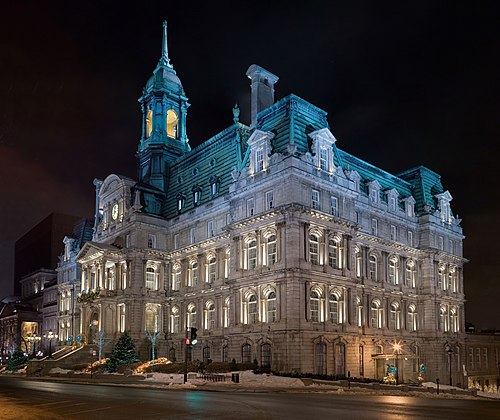Portal:Canada
| Showcase | Contents | Contributing |
Introduction
Canada is a country in North America. Its ten provinces and three territories extend from the Atlantic Ocean to the Pacific Ocean and northward into the Arctic Ocean, making it the world's second-largest country by total area, with the world's longest coastline. Its border with the United States is the world's longest international land border. The country is characterized by a wide range of both meteorologic and geological regions. With a population of just over 41 million people, it has widely varying population densities, with the majority residing in urban areas and large areas of the country being sparsely populated. Canada's capital is Ottawa and its three largest metropolitan areas are Toronto, Montreal, and Vancouver.
A developed country, Canada has a high nominal per capita income globally and its advanced economy ranks among the largest in the world by nominal GDP, relying chiefly upon its abundant natural resources and well-developed international trade networks. Recognized as a middle power, Canada's strong support for multilateralism and internationalism has been closely related to its foreign relations policies of peacekeeping and aid for developing countries. Canada promotes its domestically shared values through participation in multiple international organizations and forums. (Full article...)
Featured article -
The Beringian wolf is an extinct population of wolf (Canis lupus) that lived during the Ice Age. It inhabited what is now modern-day Alaska, Yukon, and northern British Columbia. Some of these wolves survived well into the Holocene. The Beringian wolf is an ecomorph of the gray wolf and has been comprehensively studied using a range of scientific techniques, yielding new information on their prey species and feeding behaviors. It has been determined that these wolves are morphologically distinct from modern North American wolves and genetically basal to most modern and extinct wolves. The Beringian wolf has not been assigned a subspecies classification and its relationship with the extinct European cave wolf (Canis lupus spelaeus) is not clear. (Full article...)
Current events
- April 9, 2025 – Tariffs in the second Trump administration, Executive orders in the second presidency of Donald Trump
- Canada announces a 25% tariff on certain vehicle imports from the U.S. as retaliation against a previous similar measure from the U.S. (BBC News)
- April 3, 2025 – Tariffs in the second Trump administration
- Multinational car manufacturer Stellantis announces it will lay off 900 workers across five of its U.S. factories and will pause production at assembly plants in Canada and Mexico in response to the tariffs. (Reuters)
- April 3, 2025 – Canada convoy protests
- The Ontario Court of Justice in Ontario, Canada, convicts Tamara Lich and Chris Barber, two leaders of the truck driver protest movement against COVID-19 vaccination in Canada, of criminal mischief. (AP)
- April 2, 2025 – Tariffs in the second Trump administration
- China–United States trade war, 2025 United States trade war with Canada and Mexico
- Exceptions include Canada, Cuba, Mexico, North Korea, and Russia. Canada and Mexico had tariffs placed on them in February, while Cuba, North Korea, and Russia are under U.S. sanctions. (BBC News) (France 24) (India Today)
- The United States Senate votes 51–48 on a non-binding resolution to rebuke and reverse tariffs on Canada, with Republicans Rand Paul, Susan Collins, Lisa Murkowski, and Mitch McConnell voting for the resolution. (NPR)
Selected panorama -
National symbol -

Totem poles (Haida: gyáaʼaang) are monumental carvings found in western Canada and the northwestern United States. They are a type of Northwest Coast art, consisting of poles, posts or pillars, carved with symbols or figures. They are usually made from large trees, mostly western red cedar, by First Nations and Indigenous peoples of the Pacific Northwest Coast including northern Northwest Coast Haida, Tlingit, and Tsimshian communities in Southeast Alaska and British Columbia, Kwakwaka'wakw and Nuu-chah-nulth communities in southern British Columbia, and the Coast Salish communities in Washington and British Columbia. (Full article...)
Selected vital article -
The legal system of Canada is pluralist: its foundations lie in the English common law system (inherited from its period as a colony of the British Empire), the French civil law system (inherited from its French Empire past), and Indigenous law systems developed by the various Indigenous Nations. (Full article...)
Selected picture -
Featured biography -
Frieda Fraser (30 August 1899 – 29 July 1994) was a Canadian physician, scientist and academic who worked in infectious disease, including research on scarlet fever and tuberculosis. After finishing her medical studies at the University of Toronto in 1925, she completed a two-year internship in the United States, studying and working in Manhattan and Philadelphia. Afterward, she conducted research in the Connaught Laboratories in Toronto concentrating on infectious disease, making important contributions in the pre-penicillin age to isolation of the strains of streptococci likely to lead to disease. From 1928, she lectured in the Department of Hygiene at the University of Toronto on preventive medicine, working her way up from a teaching assistant to a full professor by 1955. In college, around 1917 Fraser met her life partner, Edith Williams, and though their families tried to keep them apart, their relationship spanned until Edith's death in 1979. The correspondence between the two has been preserved and is an important legacy for the lesbian history of Canada. (Full article...)
Did you know -

- ... that the Canadian government implemented the Peasant Farm Policy to force First Nations farmers to use the methods of European peasants?
- ... that Michelle O'Bonsawin is the first Indigenous person appointed to the Supreme Court of Canada?
- ... that in 1819 Michael O'Sullivan, a member of the Legislative Assembly of Lower Canada, fought a duel in Montreal with William Caldwell over a proposal to create the Montreal General Hospital?
- ... that the Canadian Coalition for Firearm Rights has been described as "Canada's most prominent pro-gun group"?
- ... that Pituamkek National Park Reserve, Canada's newest national park, protects a chain of barrier islands that have been used for fishing and hunting by the Mi'kmaq for 4,000 years?
- ... that the Canada Centre Building has one of the first aquifer thermal energy storage systems?
- ... that the first Miss Indigenous Canada contestants were judged on ambassadorship, character, community service, and cultural involvement?
Featured list -
The Grey Cup is the championship of the Canadian Football League (CFL) and the trophy awarded to the victorious team. The trophy is named after Albert Grey, the Governor General of Canada from 1904 until 1911. He donated the trophy to the Canadian Rugby Union in 1909 to recognize the top amateur rugby football team in Canada. By this time Canadian football had become markedly different from the rugby football from which it developed. Although it was originally intended to be awarded only to amateur teams (like the Stanley Cup), over time, the Grey Cup became the property of the Canadian Football League as it evolved into a professional football league. Amateur teams ceased competing for the Cup by 1954; since 1965, the top amateur teams, playing in U Sports, have competed for the Vanier Cup. (Full article...)
Main articles
Associated Wikimedia
The following Wikimedia Foundation sister projects provide more on this subject:
-
Commons
Free media repository -
Wikibooks
Free textbooks and manuals -
Wikidata
Free knowledge base -
Wikinews
Free-content news -
Wikiquote
Collection of quotations -
Wikisource
Free-content library -
Wikiversity
Free learning tools -
Wikivoyage
Free travel guide -
Wiktionary
Dictionary and thesaurus





























